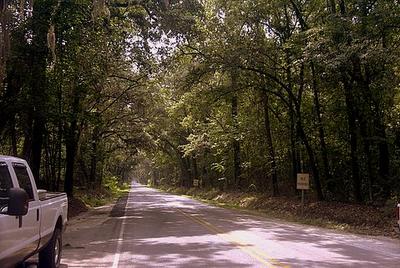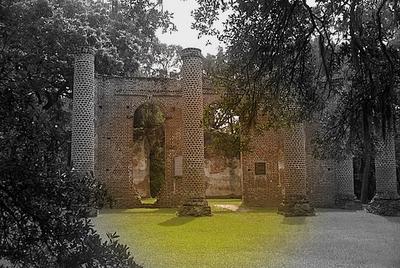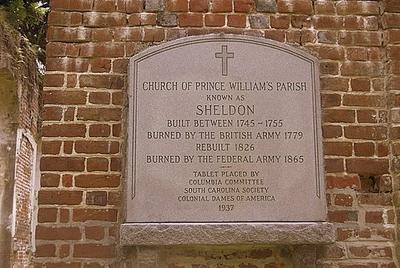The Old Sheldon Church
Highway 21 out of Beaufort, SC to the Highway 17 intersection at Gardens Corner is amazing in and of itself. The town is so entertwined with saltwater rivers, creeks and marshes that it has taken me about 7 years to get my bearings. A twenty mile drive leaving Scott's house for home takes me over Albergotti Creek and Whale Branch, places we could have gotten to by boat in about 5 minutes from the dock. Spartina grass, black plough mud, huge banks of oysters are visible at low tide and at high tide the whole place is covered in an opaque nature soup where the crabs and shrimp and finger mullet take cover in the grass to avoid the hungry fish. At low tide they are flushed out and concentrated in the main flow where they school up and create huge "V" wakes coming downt he creeks. Fruit stands and tomato fields are numerous. A left at the Gardens Corner traffic circle spills you out on Highway 17 South and a quick right 500 yards down the road puts you on Sheldon Church Road headed toward Yemassee.
I have lived in the south virtually my whole life and I know that any church out in the country will 99 times out a 100 be named after the church on that road, so seeing a road by that name did not phase me. I turned right and headed toward Yemassee down the canopied two-land road passing lime green swamp on my right and a field of ghostly huge dead bleached-out trees on my left.
 About two miles down the road, off to the right, out of the haze of the humid swamp, gnarled cypress trees and spanish moss rises majestically the ancient ruins of the Old Sheldon Church. I saw it for the first time last weekend and vowed this time to remember my camera and take some pics of this beauful relic. I'll post the pics then the story of the church.
About two miles down the road, off to the right, out of the haze of the humid swamp, gnarled cypress trees and spanish moss rises majestically the ancient ruins of the Old Sheldon Church. I saw it for the first time last weekend and vowed this time to remember my camera and take some pics of this beauful relic. I'll post the pics then the story of the church.









Resurrection amid the ruins by Carolyn Click (The Sheldon Church Story)
The gracious old live oaks bow down as if in reverence, their aged, craggy limbs lined with resurrection ferns.
At the Old Sheldon Church Ruins, set among these ancient trees, thoughts turn easily toward the Resurrection.
The remains of this 18th- century church whisper of a bygone age, of plantations and prosperity, war and want. Twice burned in the great searing conflicts of America, the majestic brick ruins somehow still speak to the hope of the church in the future.
It is a sacred place, mostly visited by the solitary traveler who may come upon it by chance. Occasionally, weddings are held there.
But on the second Sunday after Easter, members of St. Helena's Episcopal Church in nearby Beaufort gather in the shadow of the ruins for a special church service, intoning the familiar lessons and prayers. Remembering the past, celebrating the future in the Resurrection of Christ.
Afterward, there are family picnics on the grounds and the lively sounds of children as they skip and play amid the ruins.
"It is such a joy to come out here and see this become a living church," said Ruth deTreville Spieler, a lifelong member of St. Helena's.
Spieler made the annual pilgrimage to Old Sheldon last Sunday, continuing a family tradition that began for her in 1927, when her mother carried her to the church ruins as a six-month-old baby.
Spieler's ancestors were among the first families of St. Helena's, which was built in 1724 in St. Helena's Parish, shortly after the city of Beaufort was first laid out.
St. Helena's, located in the heart of Beaufort 17 miles south of the Ruins, serves as the caretaker of the Old Sheldon Church Ruins. But once both churches were thriving examples of early 18th-century colonial life.
Two-and-a-half centuries ago, the ruins were known as Sheldon Church of Prince William's Parish. It was built between 1745 and 1755, said to be the first American attempt to imitate a Greek temple.
The church was situated between two sprawling agricultural holdings, Tomotley Barony and the plantation of Lt. Gov. William Bull. In 1698, Edmund Bellinger was granted the 12,000 acres of Tomotley Barony and 36,000 more acres. He specified in his will that 50 acres be given to create a church.
The church was named in honor of Bull's family. His nearby plantation and his ancestral home in Warwickshire, England, were known as Sheldon Hall.
Histories suggest the early years were prosperous for the white plantation owners and the church. Some 60 to 70 carriages full of parishioners would regularly pull up to the entrance of Sheldon Church on a Sunday morning.
A life-size bronze statue of Prince William, for whom the parish was named, sat over the portico of the church. A large font supported by bronze lion's claws stood just inside the front entrance. It was used to baptize the white communicants and the slaves who toiled on Tomotley and Sheldon plantations.
But the American Revolution altered the lives of South Carolinians and forever changed Sheldon Church. In 1779, British troops burned it. Earlier, Prince William's statue had been removed by parishioners, and some historians have suggested that if it had been left it up, Gen. Augustine Prevost's troops might have spared the church.
The 31/2-foot thick colonnaded red brick walls still stood after the fire, as did the four portico columns. But the property remained deserted and overgrown until 1815, when planters drew up plans to rebuild the sanctuary.
The second Sheldon Church of Prince William's Parish was consecrated in 1826.
Four decades later, the flames of war once again devoured Sheldon Church, as Gen. William Tecumseh Sherman marched his federal troops from Savannah to Columbia and burned everything in his path.
Sheldon Church was never rebuilt.
For members and friends of St. Helena's, the annual church service at the ruins - begun in 1923 after a restoration of the grounds by then Rector R. Maynard Marshall and the junior choir - provides a time of remembrance and renewal. There were only a few years during World War II when the service was not held; last Sunday service was the 74th.
"It's a social event with spiritual meaning," said Charley Webb. His extended family has been coming to the service and picnic for decades.
"It's kind of a command performance for our family," said Webb, whose wife Martha Lynn and daughters Caroline, 13, and Charmian, 11, attended along with assorted cousins.
At the annual service, he can almost feel the presence of the 19th century parishioners.
"It's neat to imagine that it all has been put back together and you are worshipping with them together," he said.
But Webb took to heart the message from this year's guest speaker, the Rev. John Burwell, rector of the Church of the Holy Cross on Sullivans Island. Burwell reminded the congregation that memory and the past have their place. But simply remembering Jesus Christ does nothing, he said.
"If Jesus is just a memory, he cannot exert any power today," said Burwell. "The world is full of dead heroes, and not one of them can do a thing for me."
At the conclusion of the hour-long service, two trumpeters, one located beside the ruins, the other yards away at the south end of the property, played haunting, echoing Taps.
It seemed an odd and eerie ending to a post-Easter service, but Gerhard Spieler, St. Helena's historian, offered an explanation.
"It is a military salute usually playing at the end of the day or at a funeral," said Spieler, Ruth deTreville Spieler's husband.
"But I feel that in the case of Old Sheldon, it is not only in remembrance of the dead but, being so close to Easter, it is also a symbol of the Resurrection of the church.
"That church has been destroyed twice, its congregation has been scattered twice and yet each time it rose again - and hopefully there won't be a third time."
I have lived in the south virtually my whole life and I know that any church out in the country will 99 times out a 100 be named after the church on that road, so seeing a road by that name did not phase me. I turned right and headed toward Yemassee down the canopied two-land road passing lime green swamp on my right and a field of ghostly huge dead bleached-out trees on my left.
 About two miles down the road, off to the right, out of the haze of the humid swamp, gnarled cypress trees and spanish moss rises majestically the ancient ruins of the Old Sheldon Church. I saw it for the first time last weekend and vowed this time to remember my camera and take some pics of this beauful relic. I'll post the pics then the story of the church.
About two miles down the road, off to the right, out of the haze of the humid swamp, gnarled cypress trees and spanish moss rises majestically the ancient ruins of the Old Sheldon Church. I saw it for the first time last weekend and vowed this time to remember my camera and take some pics of this beauful relic. I'll post the pics then the story of the church.








Resurrection amid the ruins by Carolyn Click (The Sheldon Church Story)
The gracious old live oaks bow down as if in reverence, their aged, craggy limbs lined with resurrection ferns.
At the Old Sheldon Church Ruins, set among these ancient trees, thoughts turn easily toward the Resurrection.
The remains of this 18th- century church whisper of a bygone age, of plantations and prosperity, war and want. Twice burned in the great searing conflicts of America, the majestic brick ruins somehow still speak to the hope of the church in the future.
It is a sacred place, mostly visited by the solitary traveler who may come upon it by chance. Occasionally, weddings are held there.
But on the second Sunday after Easter, members of St. Helena's Episcopal Church in nearby Beaufort gather in the shadow of the ruins for a special church service, intoning the familiar lessons and prayers. Remembering the past, celebrating the future in the Resurrection of Christ.
Afterward, there are family picnics on the grounds and the lively sounds of children as they skip and play amid the ruins.
"It is such a joy to come out here and see this become a living church," said Ruth deTreville Spieler, a lifelong member of St. Helena's.
Spieler made the annual pilgrimage to Old Sheldon last Sunday, continuing a family tradition that began for her in 1927, when her mother carried her to the church ruins as a six-month-old baby.
Spieler's ancestors were among the first families of St. Helena's, which was built in 1724 in St. Helena's Parish, shortly after the city of Beaufort was first laid out.
St. Helena's, located in the heart of Beaufort 17 miles south of the Ruins, serves as the caretaker of the Old Sheldon Church Ruins. But once both churches were thriving examples of early 18th-century colonial life.
Two-and-a-half centuries ago, the ruins were known as Sheldon Church of Prince William's Parish. It was built between 1745 and 1755, said to be the first American attempt to imitate a Greek temple.
The church was situated between two sprawling agricultural holdings, Tomotley Barony and the plantation of Lt. Gov. William Bull. In 1698, Edmund Bellinger was granted the 12,000 acres of Tomotley Barony and 36,000 more acres. He specified in his will that 50 acres be given to create a church.
The church was named in honor of Bull's family. His nearby plantation and his ancestral home in Warwickshire, England, were known as Sheldon Hall.
Histories suggest the early years were prosperous for the white plantation owners and the church. Some 60 to 70 carriages full of parishioners would regularly pull up to the entrance of Sheldon Church on a Sunday morning.
A life-size bronze statue of Prince William, for whom the parish was named, sat over the portico of the church. A large font supported by bronze lion's claws stood just inside the front entrance. It was used to baptize the white communicants and the slaves who toiled on Tomotley and Sheldon plantations.
But the American Revolution altered the lives of South Carolinians and forever changed Sheldon Church. In 1779, British troops burned it. Earlier, Prince William's statue had been removed by parishioners, and some historians have suggested that if it had been left it up, Gen. Augustine Prevost's troops might have spared the church.
The 31/2-foot thick colonnaded red brick walls still stood after the fire, as did the four portico columns. But the property remained deserted and overgrown until 1815, when planters drew up plans to rebuild the sanctuary.
The second Sheldon Church of Prince William's Parish was consecrated in 1826.
Four decades later, the flames of war once again devoured Sheldon Church, as Gen. William Tecumseh Sherman marched his federal troops from Savannah to Columbia and burned everything in his path.
Sheldon Church was never rebuilt.
For members and friends of St. Helena's, the annual church service at the ruins - begun in 1923 after a restoration of the grounds by then Rector R. Maynard Marshall and the junior choir - provides a time of remembrance and renewal. There were only a few years during World War II when the service was not held; last Sunday service was the 74th.
"It's a social event with spiritual meaning," said Charley Webb. His extended family has been coming to the service and picnic for decades.
"It's kind of a command performance for our family," said Webb, whose wife Martha Lynn and daughters Caroline, 13, and Charmian, 11, attended along with assorted cousins.
At the annual service, he can almost feel the presence of the 19th century parishioners.
"It's neat to imagine that it all has been put back together and you are worshipping with them together," he said.
But Webb took to heart the message from this year's guest speaker, the Rev. John Burwell, rector of the Church of the Holy Cross on Sullivans Island. Burwell reminded the congregation that memory and the past have their place. But simply remembering Jesus Christ does nothing, he said.
"If Jesus is just a memory, he cannot exert any power today," said Burwell. "The world is full of dead heroes, and not one of them can do a thing for me."
At the conclusion of the hour-long service, two trumpeters, one located beside the ruins, the other yards away at the south end of the property, played haunting, echoing Taps.
It seemed an odd and eerie ending to a post-Easter service, but Gerhard Spieler, St. Helena's historian, offered an explanation.
"It is a military salute usually playing at the end of the day or at a funeral," said Spieler, Ruth deTreville Spieler's husband.
"But I feel that in the case of Old Sheldon, it is not only in remembrance of the dead but, being so close to Easter, it is also a symbol of the Resurrection of the church.
"That church has been destroyed twice, its congregation has been scattered twice and yet each time it rose again - and hopefully there won't be a third time."


0 Comments:
Post a Comment
<< Home